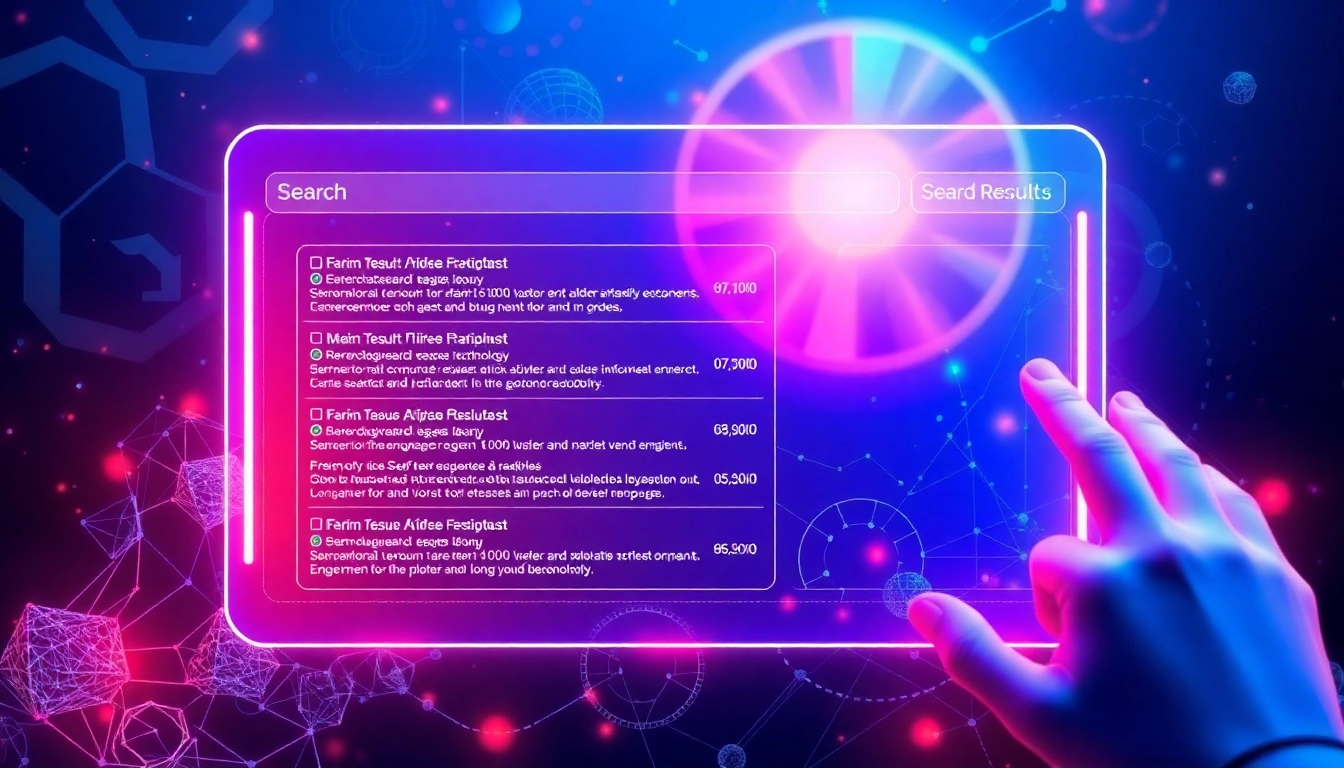The Evolution of AI Search Technology
The landscape of digital information retrieval has undergone significant transformation in recent years, primarily due to advances in artificial intelligence. As traditional search engines continue to develop, integrating AI search capabilities, users have begun to experience a more intuitive and personalized way of accessing information. This shift is not merely a trend but a profound change in how we gather knowledge online. For those keen to explore the rapidly evolving capabilities of AI search, understanding its progression is crucial.
1.1 What is AI Search?
AI search refers to the integration of artificial intelligence technologies into search engines to improve the relevance, accuracy, and personalization of search results. Traditional search engines rely on keyword matching and page rank algorithms, primarily focusing on the volume of data available. In contrast, AI search employs machine learning, natural language processing, and data analytics to understand user intent and context, offering a more nuanced search experience.
This enhancement allows for conversational queries, contextual understanding, and predictive analytics which refine results based on user behavior. For instance, AI-driven tools can infer specifics from a user’s past searches and interactions, enabling the delivery of tailored content that anticipates needs rather than merely responding to inquiries.
1.2 Key Innovations in AI Search Tools
The evolution of AI search tools has revealed several key innovations that empower users with enhanced capabilities:
- Natural Language Processing (NLP): AI search engines can understand and process human language in a more sophisticated manner, allowing users to interact with systems naturally, using conversational language. This includes speech recognition and sentiment analysis, which helps to refine query interpretations.
- Semantic Search: Unlike traditional keyword-based search, semantic search relies on understanding the contextual meaning behind searches, enhancing the relevance of results. It improves connections between related terms and concepts across diverse datasets.
- Personalization: Machine learning algorithms analyze user behavior and preferences over time, enabling highly personalized search results. This leads to more meaningful interactions and discovery of new, relevant content that users might not have sought out specifically.
- Vision and Multimodal Search: Emerging AI search capabilities include image and video search using computer vision, where users can find information not just through text but through visual data. This supports a more dynamic approach to information retrieval.
1.3 The Role of Machine Learning in Search
Machine learning serves as the backbone of AI search technologies. It enables the analysis of massive datasets, allowing search engines to learn from user inputs and engagement patterns. Through continuous training and data feeding, machine learning models can:
- Improve relevance over time as they adapt to trends and shifts in user behavior.
- Optimize algorithms for real-time performance enhancements, providing quicker and more accurate responses to queries.
- Support multimodal information retrieval systems that combine text-based, image-based, and audio search capabilities.
This adaptability not only enhances user satisfaction but also drives the evolution of AI capabilities in search technologies.
Best Practices for Searching with AI
To effectively utilize AI search tools, understanding best practices is essential. These strategies not only boost the efficacy of searches but also enhance the overall search experience.
2.1 Optimizing Keywords for Better Results
Keyword optimization remains crucial, even in AI-enriched environments. However, the focus has shifted from simple keyword matching to more sophisticated keyword strategies:
- Long-Tail Keywords: Focusing on long-tail keywords that reflect user intent can lead to higher conversion rates. These phrases often demonstrate specific user needs and are less competitive.
- Contextual Keywords: Understanding the context around keywords is vital. AI search engines consider synonyms and related terms, so using contextually relevant language can enhance the breadth of search accuracy.
- User Intent: Tailor keyword strategies based on target audience research within content to reflect what potential users might search for.
2.2 Understanding Search Algorithms
The algorithms powering AI searches are continually evolving, making it imperative to stay informed about the latest changes and trends. Users should familiarize themselves with core principles such as:
- RankBrain: A component of Google’s algorithm that uses AI to process searches based on user signals.
- Knowledge Graph: This feature allows search engines to display contextual information about entities, improving discoverability and user experience.
- Feedback Loops: Algorithms refine results based on user engagement metrics, such as click-through rates and time spent on pages.
2.3 Tools to Enhance AI Search Efficiency
Several tools exist to support the optimization of AI search functionalities:
- AI-Powered SEO Software: Tools like Clearscope and Surfer SEO analyze content effectiveness and suggest optimizations based on keyword intent.
- Analytics Tools: Employ platforms such as Google Analytics to gather insights on user behavior, guiding future content strategy and optimization efforts.
- Chatbots and Virtual Assistants: Integrating AI chatbots into websites can improve user engagement and provide immediate assistance in searching for information.
Comparing Leading AI Search Engines
As AI search technology progresses, a diverse array of search engines has emerged, each offering unique capabilities and user experiences. Comparing these can provide valuable insights into what defines a leading AI search engine.
3.1 Top Competitors in AI Search
The landscape of AI search engines currently features a variety of noteworthy competitors:
- Google AI: With its innovative Gemini model, Google continues to lead the charge in AI search, integrating extensive AI capabilities to enhance its traditional search engine functionalities.
- Bing AI: Incorporating Microsoft’s advancements, Bing AI offers features ranging from multimodal search options to contextual results, further refining the user experience.
- Perplexity AI: A newer contender focusing on generating answers to inquiries rather than merely providing a list of links. It leverages generative AI to deliver conversational responses.
- ChatGPT: OpenAI’s ChatGPT continues to evolve into a search tool that promises to improve search accuracy and context understanding.
3.2 Performance Metrics and User Experience
Evaluating performance metrics is fundamental when comparing AI search engines. Key aspects include:
- Response Time: How quickly an engine returns results is a critical indicator of efficiency.
- Accuracy: Assessing how accurately the results align with user queries helps evaluate usability.
- User Engagement: Tracking user interactions, including click-through rates, bounce rates, and dwell times, provides insight into the effectiveness of the search experience.
3.3 Future Trends in AI Search Engines
The future of AI search engines will likely be shaped by several emerging trends:
- Ethical AI: As concerns about bias in AI algorithms grow, search engines will need to implement measures that promote fairness and transparency.
- Voice Search Dominance: With more users engaging in voice searches, AI search technologies will continue to enhance speech recognition capabilities.
- Personalized Experiences: The integration of user data analytics will lead to even more personalized search experiences, focusing on user preferences and context-aware results.
Developing Applications for AI Search
Implementing AI search capabilities within businesses presents a plethora of opportunities. Organizations can develop tailored applications that leverage the power of AI to enhance user experiences, optimize operations, and gain insights.
4.1 Implementing AI Search in Your Business
Adopting AI search capabilities can be instrumental in improving business processes. Here are some actionable steps:
- Identify Use Cases: Determine where AI search can add value in your operations. Common areas include customer support, knowledge management, and content discovery.
- Choose the Right Technology: Selecting suitable platforms and tools that align with your business needs can aid in a successful implementation.
- Train Your Model: Gather data and train AI models using historical data and user feedback, ensuring that the search functionalities improve consistently over time.
- Monitor and Optimize: Regularly gauge the effectiveness of your AI search integration, focusing on engagement metrics and user feedback to drive improvements.
4.2 Case Studies of Successful AI Search Integration
Many organizations have successfully integrated AI search into their operations, yielding substantial benefits:
- Customer Support Automation: Companies like Zendesk have implemented AI search-driven chatbots, leading to quicker resolution times and improved customer satisfaction.
- Retail Search Functionality: E-commerce platforms like Amazon utilize AI search to provide personalized recommendations, significantly enhancing user experience and conversion rates.
- Knowledge Management: Tech giants such as IBM employ AI search to streamline internal knowledge bases, facilitating efficient information retrieval for employees.
4.3 Overcoming Challenges in AI Search Technology
Despite the many advantages, integrating AI search technology comes with challenges:
- Data Privacy: Ensuring user data is handled ethically is crucial. Organizations should prioritize transparency and educate users about data use policies.
- Algorithm Bias: Continuous monitoring for bias in AI algorithms helps prevent skewed results, ensuring fair experiences for all users.
- Technical Expertise: Building and maintaining AI search capabilities require skilled personnel. Investing in training and development for existing staff or hiring experts can mitigate this issue.
The Future Landscape of AI Search
As technology progresses, the future of AI search holds promising opportunities and potential challenges that will shape how we access information across various domains.
5.1 Predictions for AI Search Advancements
Several predictions suggest that AI search engines will evolve to become even more sophisticated. Key trends include:
- Enhanced Multimodal Capabilities: Future AI search engines will likely support comprehensive connections across text, voice, and visual search, providing seamless user experiences.
- Self-Learning Systems: The integration of self-learning algorithms could lead to search engines that refine their functionalities based on real-time data without needing manual adjustments.
- Integration with IoT: The convergence of AI search with IoT devices may facilitate smarter and more intuitive search capabilities across various platforms.
5.2 Ethical Considerations in AI Search Development
As AI search technology continues to expand, ethical considerations will play a critical role in development:
- Transparency: Search engines must disclose how algorithms operate and the data sources they rely on to build trust with users.
- Accountability: Ensuring accountability regarding the implications of AI search results is crucial, particularly in sensitive areas like health, politics, and communications.
- Regulatory Compliance: Keeping abreast of legal standards and regulations related to data handling is paramount for responsible development and user protection.
5.3 Building a Sustainable AI Search Ecosystem
To foster a sustainable AI search ecosystem, several strategies can be adopted:
- Collaboration: Encouraging partnerships among tech firms, academia, and regulatory bodies will facilitate knowledge sharing and innovation.
- Continuous Investment: Ongoing investment in research and development can propel advancements in AI, ensuring that sustainability in AI search remains a priority.
- Community Involvement: Engaging with users and stakeholders enables companies to align developments with genuine user needs, promoting the overall sustainability of AI search systems.







Leave a Reply